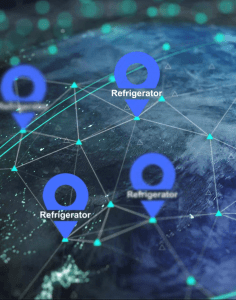A powerful recipe for innovation & growth
 Greg Balla, CEO, Aofrio.
Greg Balla, CEO, Aofrio.
Adding software to hardware –
AoFrio is a New Zealand technology leader that few local people know about. With deep manufacturing and hardware roots, the company has decades of experience supporting food and beverage companies around the world with their refrigeration.
Now, the business has innovated beyond hardware and invented the world’s first Internet of Things (IoT) platform for commercial refrigeration.
The combinations of hardware, like motors and fans, and smart IoT-enabled refrigeration controllers and sensors help customers sell more products, save costs, track assets, gain insights to do business better and save on energy and carbon emissions.
AoFrio is growing into a hardware-enabled, software as a service (SaaS) provider.
It’s their pathway to lifting recurring revenue (because they sell their solution ongoing to customers), to expanding in existing markets and exploring new regions around the world.
But the path to getting there has been long and not without its challenges.
In the words of Greg Balla, CEO of AoFrio:
From where I sit now, it’s easy to see a future where hundreds of millions of refrigerators around the world are connected to AoFrio’s platforms, giving us data to drive powerful, purposeful outcomes for customers.
But there are many moments in AoFrio’s history that plotted the way to becoming the company we are today. We’re now in the position where we can couple our hardware abilities with software and data-driven insights to give clear customer insights and actions that are impactful to their bottom line.
 One of the turning points for us is around 2012. The company was tired of purely competing on price. Deciding instead to design the best refrigeration motor in the world. We set a goal that our electronically controlled motor would be better than the competition in every single respect.
One of the turning points for us is around 2012. The company was tired of purely competing on price. Deciding instead to design the best refrigeration motor in the world. We set a goal that our electronically controlled motor would be better than the competition in every single respect.
Most of our competitors looked at what we were doing and laughed. They thought nobody would buy it. The industry had been trudging along for years, producing what they thought customers wanted. The team dug deep into our customers’ needs and produced what they actually wanted.
With electronics’ costs decreasing and microprocessors becoming cheaper, we took a lot of the techniques that had only been applied to large motors and applied them to small ones. While everyone in our industry was jumping to the right, we took a massive leap to the left.
The conscious decision to innovate began to drive a culture of continually pushing boundaries. We now have 30 people in our R&D team, with a worldwide head count of around 100 people. Their job is to develop new products and innovate existing products.
But all the team, at some point in their day, are involved in innovating. We use a proven stage-gate process to move products and solutions from ideation to launch.
We are ensuring that we do not shift out of this culture as we grow. Now, 15-20% of everyone’s roles is focused on learning and innovating, across the whole organisation. We provide them with the space and time to do that.
IoT is relatively new in commercial refrigeration.
Nearly two years ago, we began employing Customer Success Managers. With deep knowledge of technology and commercial refrigeration, the Managers help drive maximum performance gains for customers which accelerates further adoption and drives data acquisition, providing us with deeper insights.
Managers feed new feature ideas and customer issues into a platform called JIRA, an agile, project management tool, linking directly to the R&D and engineering team. This system drives further innovation.
Today, we’re well and truly becoming a hardware-enabled SaaS company that sells our software as a service to customers ongoing. We still make the best electronically controlled motor, but we do much more.
It gives us diversified revenue streams. It means we can connect our customers to their data, helping them drive meaningful differences to their businesses – and we’re doing it from New Zealand.
We’re proudly headquartered and listed in New Zealand, but we trade in 31 countries and our team are located across 10 offices around the world.
From here, we’re taking the best of our hardware skills and coupling that with software to lift the game on a global scale.
So far, we’ve installed more than three million motors, resulting in an energy savings equivalent to what New Zealand’s largest thermal power station takes four and a half years to produce – but we’re only just getting started.



